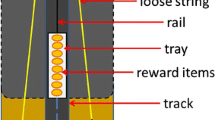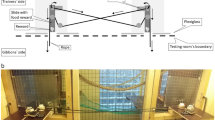Abstract
A key aspect of cooperation is partner choice: choosing the best available partner improves the chances of a successful cooperative interaction and decreases the likelihood of being exploited. However, in studies on cooperation subjects are rarely allowed to freely choose their partners. Group-living animals live in a complex social environment where they can choose among several social partners differing in, for example, sex, age, temperament, or dominance status. Our study investigated whether wild Barbary macaques succeed to cooperate using an experimental apparatus, and whether individual and social factors affect their choice of partners and the degree of cooperation. We used the string pulling task that requires two monkeys to manipulate simultaneously a rope in order to receive a food reward. The monkeys were free to interact with the apparatus or not and to choose their partner. The results showed that Barbary macaques are able to pair up with a partner to cooperate using the apparatus. High level of tolerance between monkeys was necessary for the initiation of successful cooperation, while strong social bond positively affected the maintenance of cooperative interactions. Dominance status, sex, age, and temperament of the subjects also affected their choice and performance. These factors thus need to be taken into account in cooperative experiment on animals. Tolerance between social partners is likely to be a prerequisite for the evolution of cooperation.




Similar content being viewed by others
References
Altmann J (1974) Observational study of behavior: sampling methods. Behaviour 49:227–267
Balasubramaniam KN, Dittmar K, Berman CM, Butovskaya M, Cooper MA, Majolo B, Ogawa H, Schino G, Thierry B, de Waal FBM (2012) Hierarchical steepness, counter-aggression, and macaque social style scale. Am J Primatol 74:915–925
Berghänel A, Ostner J, Schröder U, Schülke O (2011) Social bonds predict future cooperation in male Barbary macaques, Macaca sylvanus. Anim Behav 81:1109–1116
Bergmüller R, Schürch R, Hamilton IM (2010) Evolutionary causes and consequences of consistent individual variation in cooperative behaviour. Philos Trans R Soc B 365:2751–2764
Boesch C, Boesch H (1989) Hunting behavior of wild chimpanzees in the Tai national park. Am J Phys Anthropol 78:547–573
Burton JJ (1977) Absence de comportement coopératif spontané dans une troupe de Macaca fuscata en présence de pierres appâtées. Primates 18:359–366
Carne C, Wiper S, Semple S (2011) Reciprocation and interchange of grooming, agonistic support, feeding tolerance, and aggression in semi-free-ranging Barbary macaques. Am J Primatol 73:1127–1133
Carrete M, Tella JT (2010) Individual consistency in flight initiation distances in burrowing owls: a new hypothesis on disturbance-induced habitat selection. Biol Lett 6:167–170
Carter AJ, Goldizen AW, Tromp SA (2010) Agamas exhibit behavioral syndromes: bolder males bask and feed more but may suffer higher predation. Behav Ecol 21:655–661
Chalmeau R, Gallo A (1993) Social constraints determine what is learned in the chimpanzee. Behav Proc 28:173–180
Chalmeau R, Lardeux K, Brandibas P, Gallo A (1997) Cooperative problem solving by orangutans (Pongo pygmaeus). Int J Primatol 18:23–32
Crawford MP (1937) The cooperative solving of problems by young chimpanzees. Comp Psychol Monogr 14:1–88
Cronin KA (2012) Prosocial behaviour in animals: the influence of social relationships, communication and rewards. Anim Behav 84:1085–1093
Cronin KA, Kurian AV, Snowdon CT (2005) Cooperative problem solving in a cooperatively breeding primate (Saguinus oedipus). Anim Behav 69:133–142
de Vries H, Netto WJ, Hanegraaf PLH (1993) Matman: a program for the analysis of sociometric matrices and behavioural transition matrices. Behaviour 125:157–175
de Waal FBM (2000) Attitudinal reciprocity in food sharing among brown capuchin monkeys. Anim Behav 60:253–261
de Waal FBM, Davis JM (2003) Capuchin cognitive ecology: cooperation based on projected returns. Neuropsychologia 41:221–228
de Waal FBM, Suchak M (2010) Prosocial primates: selfish and unselfish motivations. Philos Trans R Soc B 365:2711–2722
de Waal FBM, van Hooff JARAM (1981) Side-directed communication and agonistic interactions in chimpanzees. Behaviour 77:164–198
Deag JM, Crook JH (1971) Social behaviour and ‘agonistic buffering’ in the wild Barbary macaque Macaca sylvana L. Folia Primatol 15:183–200
Drea CM, Carter AN (2009) Cooperative problem solving in a social carnivore. Anim Behav 78:967–977
Fady JC (1972) Absence de coopération de type instrumental en milieu nature1 chez Papio papio. Behaviour 93:157–164
Fairbanks LA (2001) Individual differences in response to a stranger: social impulsivity as a dimension of temperament in vervet monkeys (Cercopithecus aethiops sabaeus). J Comp Psychol 115:22–28
Gilby IC, Eberly LE, Wrangham RW (2008) Economic profitability of social predation among wild chimpanzees: individual variation promotes cooperation. Anim Behav 75:351–360
Hare B (2007) From nonhuman to human mind: what changed and why. Curr Dir Psychol Sci 16:60–64
Hare B, Melis AP, Woods V, Hastings S, Wrangham RW (2007) Tolerance allows bonobos to outperform chimpanzees on a cooperative task. Curr Biol 17:619–623
Hauser MD, Chen MK, Chen F, Chuang E (2003) Give unto others: genetically unrelated cotton-top tamarin monkeys preferentially give food to those who altruistically give food back. Proc R Soc B 270:2363–2370
Heinsohn R, Packer C (1995) Complex cooperative strategies in group-territorial African lions. Science 269:1260–1262
Hirata S, Fuwa K (2007) Chimpanzees (Pan troglodytes) learn to act with other individuals in a cooperative task. Primates 48:13–21
Huntingford FA (1976) The relationship between anti-predator behaviour and aggression among conspecifics in the three-spined stickleback, Gasterosteus aculeatus. Anim Behav 24:245–260
Jaeggi AV, Burkart JM, van Schaik CP (2010) On the psychology of cooperation in humans and other primates: combining the natural history and experimental evidence of prosociality. Philos Trans R Soc B 365:2723–2735
Kaburu SSK, MacLarnon A, Majolo B, Qarro M, Semple S (2012) Dominance rank and self-scratching among wild female Barbary macaques (Macaca sylvanus). Afr Zool 47:74–79
Kümmerli R, Martin RD (2008) Patterns of infant handling and relatedness in Barbary macaques (Macaca sylvanus) on Gibraltar. Primates 49:271–282
Lehmann J, Boesch C (2008) Sex differences in chimpanzee sociality. Int J Primatol 29:65–81
Majolo B, Ames K, Brumpton R, Garratt R, Hall K, Wilson N (2006) Human friendship favours cooperation in the iterated Prisoner’s Dilemma. Behaviour 143:1383–1395
Maréchal L, Semple S, Majolo B, Qarro M, MacLarnon A (2011) Impacts of tourism on anxiety and physiological stress in wild male Barbary macaques. Biol Conserv 144:2188–2193
Massen JJM, Koski SE (2014) Chimps of a feather sit together: chimpanzee friendships are based on homophily in personality. Evol Hum Behav 35:1–8
McFarland R, Majolo B (2011) Exploring the components, asymmetry and distribution of relationship quality in wild Barbary macaques (Macaca sylvanus). PLoS One 6:e28826
McNamara JM, Barta Z, Houston AI (2004) Variation promotes cooperation in the Prisoner’s Dilemma game. Nature 428:745–747
McNamara JM, Leimar O (2010) Variation and the response to variation as a basis for successful cooperation. Philos Trans R Soc B 365:2627–2633
Melis AP, Hare B, Tomasello M (2006a) Chimpanzees recruit the best collaborators. Science 311:1297–1300
Melis AP, Hare B, Tomasello M (2006b) Engineering cooperation in chimpanzees: tolerance constraints on cooperation. Anim Behav 72:275–286
Melis AP, Semmann D (2010) How is human cooperation different? Phil Trans R Soc B 365:2663–2674
Mendres KA, de Waal FBM (2000) Capuchins do cooperate: the advantage of an intuitive task. Anim Behav 60:523–529
Meunier H, Deneubourg JL, Petit O (2008) How many for dinner? Recruitment and monitoring by glances in capuchins. Primates 49:26–31
Mitchell G, Tokunaga DH (1976) Sex differences in nonhuman primate grooming. Behav Proc 4:335–345
Møller AP, Nielsen JT, Garamzegi LZ (2008) Risk taking by singing males. Behav Ecol 19:41–53
Möslinger H, Kotrschal K, Huber L, Range F, Virányi Z (2009) Cooperative string-pulling in wolves. J Vet Behav 4:99
Noë R (2001) Biological markets: partner choice as the driving force behind the evolution of cooperation. In: Noë R, van Hooff JARAM, Hammerstein P (eds) Economics in nature: social dilemmas, mate choice and biological markets. Cambridge University Press, Cambridge, pp 93–118
Noë R (2006) Cooperation experiments: coordination through communication versus acting apart together. Anim Behav 71:1–18
Noldus Information Technology (2003) Matman, software for matrix manipulation and analysis, version 1.1. Wageningen, The Netherlands
Nunn CL, Deaner RO (2004) Patterns of participation and free riding in territorial conflicts among ringtailed lemurs (Lemur catta). Behav Ecol Sociobiol 57:50–61
Pansini R (2011) Induced cooperation to access a sharable reward increases the hierarchical segregation of wild vervet monkeys. PLoS One 6:e21993
Paul A, Kuester J, Arnemann J (1996) The sociobiology of male-infant interactions in Barbary macaques (Macaca sylvanus). Anim Behav 51:155–170
Pereira ME, Fairbanks LA (2002) Juvenile primates: life history, development and behavior, with a new foreword. University of Chicago Press, Chicago
Péron F, Rat-Fischer L, Lalot M, Nagle L, Bovet D (2011) Cooperative problem solving in African grey parrots (Psittacus erithacus). Anim Cogn 14:545–553
Petit O, Desportes C, Thierry B (1992) Differential probability of ‘coproduction’ in two species of macaque (Macaca tonkeana, M. mulatta). Ethology 90:107–120
Pinheiro JC, Bates DM (2000) Mixed effects models in S and S-PLUS, 1st edn. Springer, New York
Plotnik JM, Lair R, Suphachoksahakun W, de Waal FBM (2011) Elephants know when they need a helping trunk in a cooperative task. Proc Natl Acad Sci USA 108:5116–5121
Scheid C, Noë R (2010) The performance of rooks in a cooperative task depends on their temperament. Anim Cogn 13:545–553
Schino G, Aureli F (2009) Reciprocal altruism in primates: partner choice, cognition and emotions. Adv Stud Behav 39:45–69
Schwab C, Swoboda R, Kotrschal K, Bugnyar T (2012) Recipients affect prosocial and altruistic choices in jackdaws, Corvus monedula. PLoS One 7:e34922
Seed AM, Clayton NS, Emery NJ (2008) Cooperative problem solving in rooks (Corvus frugilegus). Proc R Soc B 275:1421–1429
Silk JB (2003) Cooperation without counting: the puzzle of friendship. In: Hammerstein P (ed) The genetic and cultural evolution of cooperation. The MIT Press, Cambridge, pp 37–54
Silk JB, Altmann J, Alberts S (2006) Social relationships among adult female baboons (Papio cynocephalus) I. Variation in the strength of social bonds. Behav Ecol Sociobiol 61:183–195
Stankowich T, Coss RG (2005) Effects of predator behavior and proximity on risk assessment by Columbian black-tailed deer. Behav Ecol 17:246–254
Stevens JR, Hauser MD (2004) Why be nice? Psychological constraints on the evolution of cooperation. Trends Cogn Sci 8:60–65
Suchak M, Eppley TM, Campbell MW, de Waal FBM (2014) Ape duos and trios: spontaneous cooperation with free partner choice in chimpanzees. PeerJ 2:e417
Sueur C, Petit O (2009) Signals use by leaders in Macaca tonkeana and Macaca mulatta: group-mate recruitment and behaviour monitoring. Anim Cogn 13:239–248
Thierry B, Singh M, Kaumanns W (2004) Macaque societies: a model for the study of social organization. Cambridge University Press, Cambridge
Widdig A, Streich W, Tembrock G (2000) Coalition formation among male Barbary macaques (Macaca sylvanus). Am J Primatol 50:37–51
Wilson DS, Clark AB, Coleman K, Dearstyne T (1994) Shyness and boldness in humans and other animals. Trends Ecol Evol 9:442–446
Acknowledgments
We would like to thank the Haut Commissariat aux Eaux et Forêts et à la Lutte Contre la Désertification of Morocco for permission to conduct the research, and Professor Mohamed Qarro (Ecole Nationale Forestière d’Ingénieurs, Morocco) for his support. We are grateful to Jean-Marc Buonomano, Neal Marquez, Barbora Kuběnová, and Laura Martínez Íñigo for assistance in the field. Finally, we would like to thank Sue Wiper and Trentham Monkey Forest for allowing us to pilot the use of the apparatus with the Barbary macaques housed at the park.
Author information
Authors and Affiliations
Corresponding author
Ethics declarations
Our study complies with the ASAB Guidelines for the Treatment of Animals in Behavioural Research and Teaching. All procedures performed for this study were in accordance with the ethical standards of the University of Lincoln and of Morocco.
Conflict of interest
The authors declare that there is no conflict of interest in the conduct and reporting of this research.
Electronic supplementary material
Below is the link to the electronic supplementary material.
Rights and permissions
About this article
Cite this article
Molesti, S., Majolo, B. Cooperation in wild Barbary macaques: factors affecting free partner choice. Anim Cogn 19, 133–146 (2016). https://doi.org/10.1007/s10071-015-0919-4
Received:
Revised:
Accepted:
Published:
Issue Date:
DOI: https://doi.org/10.1007/s10071-015-0919-4




